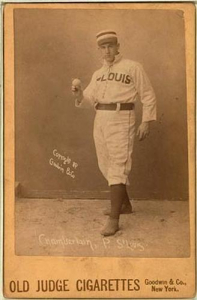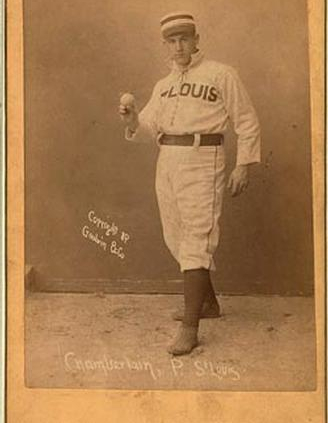September 23, 1893: Chamberlain ices Beaneaters in darkness-shortened no-hitter
 “He used a slow ball during the entire game and was a puzzle the Bostons were unable to solve,” noted the Cincinnati Enquirer about the Cincinnati Reds’ Ice Box Chamberlain’s darkness-shortened, seven-inning no-hitter to complete a doubleheader sweep against the Boston Beaneaters.1
“He used a slow ball during the entire game and was a puzzle the Bostons were unable to solve,” noted the Cincinnati Enquirer about the Cincinnati Reds’ Ice Box Chamberlain’s darkness-shortened, seven-inning no-hitter to complete a doubleheader sweep against the Boston Beaneaters.1
It had been a lackluster season for both the Reds and Chamberlain. On a season-ending 17-game homestand, player-manager Charlie Comiskey’s club (58-62) was in seventh place in the 12-team NL. The Reds were in danger of falling into the second division for the third time in their history, which dated to 1882 as an original member of the American Association.
Elton Chamberlain, whose moniker, according to baseball historian Lee Allen, arose from his cool demeanor under pressure,2 was a colorful character in a sport filled with them in the 1890s. According to Charles F. Faber, Chamberlain enjoyed his sudsy beverages and also fisticuffs;3 he could also pitch with both hands—and did on at least two occasions—but was a natural right-hander.4
The 25-year-old was a veritable workhorse, despite his small, 5-foot-9, 160-pound stature. Entering the 1893 season, he had eclipsed the 400-inning threshold three times in four seasons. He was coming off a 19-23 record in his first season with the Reds, having spent his first six campaigns with four different American Association clubs.
A major rule change, however, affected Chamberlain greatly in 1893. As John Thorn and Erik Miklich explained, that season the 5½-foot-deep and 4-foot-wide pitcher’s box, the back of which was 55½ feet from home plate, was replaced with a pitcher’s rubber, located the now recognizable 60 feet and 6 inches from home plate.5 Chamberlain developed arm pain, and completed just 19 of his 27 starts after completing 43 of 49 a year earlier. The Enquirer described him as “erratic” and wondered if his right arm had “lost its cunning.”6
With eight games to play, skipper Frank Selee’s Beaneaters (83-38) were cruising to their third straight pennant. In the midst of a season-ending 18-game road swing, they had won just two of their last nine games, but still maintained a 9½-game lead over the Pittsburgh Pirates.
Rain had caused the second game of a three-game series to be rescheduled as part of a Saturday afternoon twin bill in the Queen City. On a pleasant autumnal day, with temperatures in the mid-70s,7 a crowd of 2,898 ventured to League Park, the nine-year-old wooden ballpark at the intersection of Findlay and Western Avenues where the Reds eventually played until mid-1970, albeit in different structures.
The Enquirer described the first game as “one of the most exciting contests ever witnessed in this city.”8 The Reds tallied five unanswered runs to take a 5-1 lead after five innings. The Beaneaters, propelled by the league’s highest-scoring offense during the 1893 campaign (7.7 runs per game), then rallied, tying the game with a three-run outburst in the seventh. In the bottom of the ninth, Reds rookie Jack McCarthy stroked a one-out double and rode home on Jim Canavan’s fly out for the win.
A brouhaha erupted during intermission. The game’s only arbiter, John Gaffney, “refused to umpire” the second contest, reported the Enquirer.9 According to the paper, Gaffney claimed his contract did not call him to work twice in one day. The Boston Herald offered a different reason, noting that he had “hurt his back.”10
That might have been polite obfuscation for Gaffney, once described as the “King of Umpires.”11 Gaffney had become increasingly unreliable during the season as he battled drinking problems, and was released by the NL at the end of the season. In his stead stepped Billy Klusman, who twice had cups of coffee in the majors, including with Boston in 1888, and had just finished the year with Savannah in the Class B Southern Association. “Some of his decisions were at times queer looking,” opined the Enquirer, but given that Klusman had never umpired before, he “did as well as could be expected.”12
The Reds teed off on the Beaneaters’ 28-year-old starter, Hank Gastright. Three years removed from a 30-win, 400-plus-inning campaign with the Columbus Solons in the American Association, Gastright had signed as a free agent with the Beaneaters in June after his release from the Pirates. He was en route to a 15-5 record (12-4 with the Beaneaters) to push his career slate to 70-57 in parts of five seasons.
In the first inning, Cincinnati leadoff hitter Bug Holliday reached on third baseman Billy Nash’s error. After Arlie Latham was plunked, both moved up on a passed ball. Bid McPhee’s fly ball accounted for the first run, followed by McCarthy’s RBI single.
With the way Chamberlain iced the Beans, two runs were more than enough, but the league’s weakest-hitting (.259 batting average) and third-lowest-scoring (5.8 runs per game) team squeezed out a few more. Farmer Vaughn stroked a two-run double in the fourth, plating McCarthy, who had led off with a walk, and Frank Motz, who had singled. Vaughn advanced on Canavan’s sacrifice bunt and made it 5-0 when he scored on Germany Smith’s fly out.
Latham’s “daring baserunning” in the fifth inning accounted for the Reds’ final run and the most excitement in the game.13 He drew a free pass, stole second and third, and then scored on a passed ball that, according to the Boston Globe, only “bounded back 10 feet from home plate.”14
Chamberlain was in complete control the entire game, yielding only four baserunners. In the second he walked Charlie Ganzel, who was immediately forced by Cliff Carroll. Charlie Bennett led off the next frame with another free pass but failed to advance. Tommy Tucker reached on first baseman Motz’s error in the fourth. An inning later, Chamberlain plunked Bobby Lowe, who moved to second on a wild pitch, but advanced no farther. Lowe was the only Beaneater to reach the keystone sack in the game.
Boston “made only two cracks out of the box that could claim to be even distant reflections of a hit,” reported the Globe.15 A smash from Tucker “whizzed past Herr Motz’ shins” at third but was a foul. An unidentified batter launched a deep fly that “went whirling through space like a dog-eared meteor” but was a routine out.
In increasingly dark playing conditions, Chamberlain breezed through the seventh inning. Germany Smith scooped up Carroll’s grounder to short and tossed to Motz at first to end the game in 1 hour and 20 minutes and complete the doubleheader sweep. “The champions came down with a thump this afternoon,” declared the Boston Herald.16
“Pitcher Chamberlain Puzzled the Champs,” ran a subhead in the Enquirer.17 The popular hurler walked two and did not strike out a batter in his seven-inning no-hitter to help the Reds to their fifth straight victory.
After a loss to the Brooklyn Grooms the next day, the Reds won their final five games to finish the season in sixth place (65-63) and in the first division. Chamberlain concluded what proved to be his last productive season with a 16-12 record to push his career slate to 147-110. A year later, Chamberlain’s career was on ice, out of the majors at the age of 26, though he had a brief two-game comeback in 1896.
Chamberlain’s abbreviated no-hitter inducted him into the prestigious fraternity of no-hit pitchers. He was member of that club for 98 years, until September 1991, when the Committee for Statistical Accuracy, chaired by Commissioner Fay Vincent, amended the definition of a no-hitter to include only those games that last at least nine innings and end with no hits. An estimated 36 abbreviated no-hitters were removed from the ranks, including Chamberlain’s darkness-shortened gem in the Queen City on the Ohio River.
Acknowledgments
This game was fact-checked by Stew Thornley and copy-edited by Len Levin.
Sources
In addition to the sources cited in the Notes, the author accessed Retrosheet.org, Baseball-Reference.com, and SABR.org.
Notes
1 “Clean Was the Reds Work,” Cincinnati Enquirer, September 24, 1893: 6.
2 Charles F. Faber, “Ice Box Chamberlain,” SABR BioProject. https://sabr.org/bioproj/person/ice-box-chamberlain/.
3 Charles F. Faber, “Ice Box Chamberlain.”
4 New York Clipper, August 22, 1891, quoted from Bill James and Rob Neyer, The Neyer/James Guide to Pitchers (New York: Fireside Books, 2004), 161.
5 Erik Miklich, “The Pitcher’s Area,” 19C Base Ball, Accessed December 2, 2022: http://www.19cbaseball.com/field-8.html; John Thorn, “A Brief History of the Pitching Distance,” Our Game, February 27, 2015, https://ourgame.mlblogs.com/a-brief-history-of-the-pitching-distance-3210e7874d5c.
6 “Clean Was the Reds Work.”
7 “Weather Forecast,” Cincinnati Enquirer, September 24, 1893: 4.
8 “Clean Was the Reds Work.”
9 “Clean Was the Reds Work.”
10 “Still Picking Up Lost Games,” Boston Herald, September 24, 1893: 4.
11 “‘King of Umpires’ Dead,” Boston Globe, August 8, 1913: 3.
12 “Clean Was the Reds Work.”
13 “Clean Was the Reds Work.”
14 “Beaten in Both,” Boston Globe, September 24, 1893: 6.
15 “Beaten in Both.”
16 “Still Picking Up Lost Games.”
17 “Clean Was the Reds Work.”
Additional Stats
Cincinnati Reds 6
Boston Beaneaters 0
7 innings
Game 2, DH
League Park
Cincinnati, OH
Corrections? Additions?
If you can help us improve this game story, contact us.


